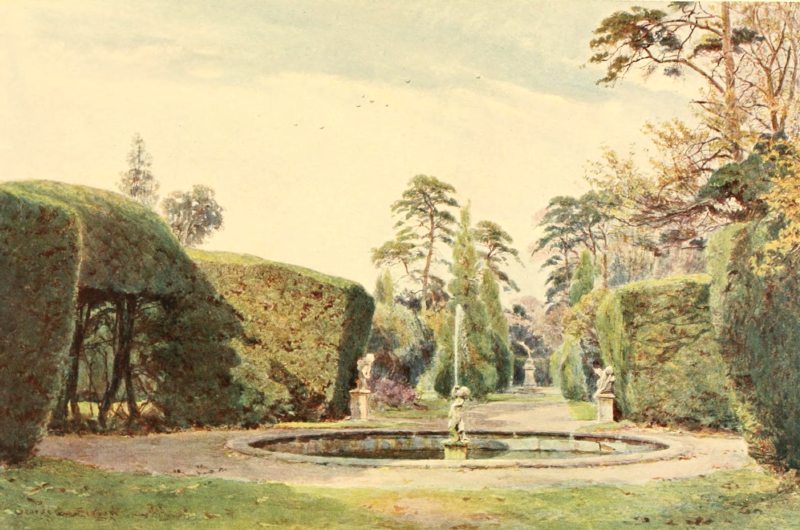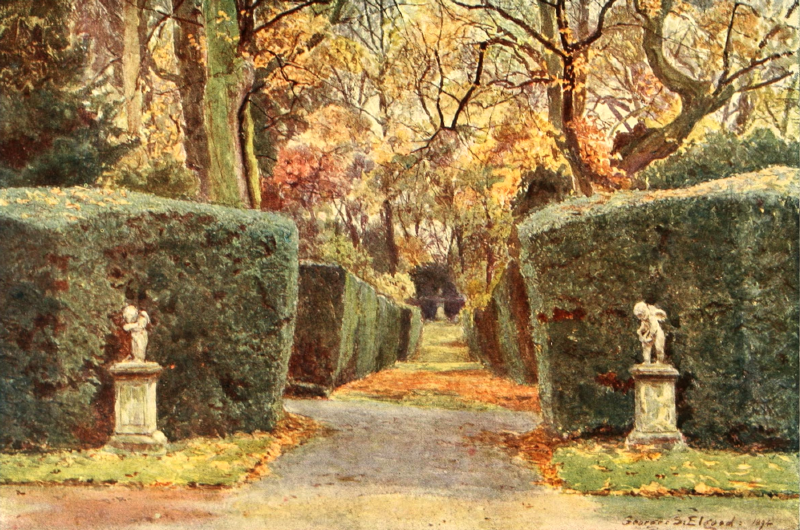| Web
and Book design,
Copyright, Kellscraft Studio 1999-2021 (Return to Web Text-ures) |
 (HOME)
|
|
MELBOURNE
The
gardens of Melbourne Hall in Derbyshire, the property of Earl Cowper, but
occupied for the last five-and-twenty years by Mr. W. D. Fane, though perhaps
less well preserved than those of Bramham, still show the design of Henry Wise
in the early years of the eighteenth century. There had formerly been an older
garden. Wise's plan shows how completely the French ideas had been adopted in England,
for here again are the handsome pools and fountains, the garden thick-hedged
with yew, and the bosquet with its straight paths, green-walled, leading to a
large fountain-centred circle in the thickest of the grove. The
whole space occupied by the house and grounds is not of great extent; it is irregular
and even awkward in shape, and has roads on two sides. The
treatment is extremely ingenious; indeed, it is doubtful whether any other plan
that could have been devised would have made so much of the space or could have
so cleverly concealed the limits. The
garden lies out forward of the house in a long parallelogram. Next to the
house-front is the usual wide gravel terrace, from which paths, inclosing
spaces of lawn, lead down to a lower level. The whole lawn, with its
accompanying paths, slopes downward; where a steeper slope occurs above and
below, the path becomes a flight of steps. The
lower level is intersected by paths. As they converge, they swing round the
pedestal of the Flying Mercury that stands upon a circular grass-plot. The main
path soon reaches the edge of the handsome pool known as the Great Water. It is
four-sided, with a further semi-circular bay, A wide grass-verge and turf slope
form the edging. Broad walks pass all round, with pleasant views at various
points into the cool and shaded woodland alleys. Near the further angles of the
pool's green court, the great yew hedge, which bounds the whole garden, swings
back into shallow segmental niches to take curved stone seats. Just beyond, on
the return angle, the view from the path, here passing the right side of the
pool, is ended by the lead figure of Perseus, of heroic size, also standing in
a niche cut in the yews. The companion statue of Andromeda occupies the
corresponding niche on the other side. After
passing the Mercury, the view across the pool is met by a curious piece of
wrought-iron work in the form of a high, dome-topped summer-house; a
masterpiece of Jean Tijou. It is entered by steps, and leads, through the
trees, to higher ground beyond. Right
and left of the middle and upper portions of the garden the great yew hedges
are double; planted in parallel lines, with an open space between. Scotch Firs,
now very old and towering high aloft, give great character to this part of the
garden. In one place there are three parallel hedges of yew, the two outermost
forming the "Dark Arbour," a tunnel of yew a hundred yards in length,
only broken near its lower end, where a small fountain marks the crossing of a
broad path. All
the lower portion of the garden is surrounded by a dense grove of trees, in
which other tall Scotch Firs stand out conspicuously. Its most extensive area
is on the right side of the Great Water, where several grassy paths, bounded by
clipped hedges of yew and lime, radiate from a large circular space where there
is a wide, round basin and fountain-jet. Looking along one of the pleasant
green ways, other jets are seen springing from further fountains where more
paths cross. The ends of some of the walks are finished with alcoves or
arbours. One of them, that runs diagonally from the right-hand side of the
large pool, crosses the great wood fountain, and passing on some distance
further ends at a magnificent lead urn on a massive
pedestal. This is also the terminal point of view of another of the longest of
the green paths.  MELBOURNE From the picture in the possession of Mr. W. V. R. Fane
The
water that supplies the pools and fountains comes from a wild pond, the home of
many wild-fowl, that is on a higher level, outside the grounds and beyond one
of the roads that bounds them. A stream from the pond meanders through the
wooded ground, and is conducted by a culvert to the large pool; the overflow
passing out on the opposite side in the same way. Important
in the garden's decoration are the unusual number of lead statues and other
accessories, of excellent design. The upper lawn has two kneeling figures of
negro or Indian type, bearing on their heads, partly supported by their hands,
circular tables with moulded edges that carry an urn-finial. The central
ornament of the next level is the Flying Mercury, after John of Bologna.
Referring to this example, Messrs. Blomfield and Inigo Thomas tell us in "
The Formal Garden in England " that " lead statues very easily lose
their centre of gravity." This is exemplified by the Mercury at Melbourne,
which has already come over to a degree which makes its evident want of balance
distressing to the eye of the beholder, and forebodes its eventual downfall. Lead
as a material for such use in gardens is much more suitable to the English
climate than marble. It acquires a beautiful silvery colouring with age,
whereas marble becomes disfigured with blackish weather-streaks. During the
eighteenth century the art of lead casting came to great perfection in England.
Some good models came from Italy; the original of the kneeling slave at
Melbourne is considered to have come from there. Others were brought from
France. The inspiration, if not the actual designs or moulds, of the many
charming figures of amorini in these
gardens must have been purely French. The pictures show how they were used.
They stand on pedestals at several of the points of departure of the green
glades. In fountain basins they form jets; the little figure appearing to blow
the water through a conch-shell. They are also shown, sometimes singly,
sometimes in pairs, disputing, wrestling or carrying a cornucopia of flowers.
One little fellow, alone on his pedestal, is whittling his bow with a tool like
a wheelwright's draw-knife. All are charming and
graceful. They are probably more beautiful now than of old, when they were
painted and sanded to look like stone.  From the picture in the possession of Mr. J. W. Ford There
were several lead foundries in London early in the eighteenth century for the
making of these garden ornaments. The foremost was that of John Van Nost. Mr.
Lethaby in his book, on Leadwork tells us that this Dutch sculptor came to
England with King William III.; that his business was taken in 1739 by Mr. John
Cheere, who served his time with his brother. Sir H. Cheere, who made several
of the Abbey monuments. The kneeling slave, bearing either a vase, as at
Melbourne, or a sundial as in the Temple Gardens in London, and in other
pleasure grounds in different parts of the country, was apparently a favourite subject.
The figure, not always from the same mould in the various examples, but always
showing good design, was evidently of Italian origin. Towards the end of the
century, designs for lead figures became much debased, and such subjects as
people sitting round a table, painted like life, could not possibly have served
any decorative purpose. The natural colour of lead is so good that no painting
can improve it. In Tudor days it was often gilt, a much more permissible treatment.
In the old days there was probably a parterre at Melbourne, now no longer existing. The figures of kneeling slaves were possibly the centre ornaments of its two divisions, on what is now the upper lawn. This portion of the garden is rather liberally, and perhaps somewhat injudiciously, planted with a mixture of conifers, put in probably thirty to forty years ago, when the remains of good old garden designs were not so reverently treated, nor their value so well understood, as now. Some of this planting has even strayed to the banks of the Great Water. The pleasure ground of Melbourne is a precious relic of the past, and, even though the ill effects of the modern planting of various conifers may be less generally conspicuous there than it is in many places, yet it is distinctly an intrusion. The tall trees inclosed by massive yew hedges, the pools and fountains, the statues and other sculptured ornaments, all recall, with their special character of garden treatment, the times and incidents that Watteau loved to paint. Such a picture as his Bosquet de Bacchus, so well known by the engraving, with its gaily-dressed groups of young men and maidens seated in the grassy shade and making the music of their lutes and voices accompany that of the fountains' waters, might have been painted at Melbourne. For here are the same wide, green-walled alleys, the pools, the fountains and the ornamental details of the great gardens of courtly France of two hundred years ago acclimatised on English soil; not in the dreary vastness of Versailles, but tamed to our climate's needs and on a scale attuned to the more moderate dimensions of a reasonable human dwelling. |